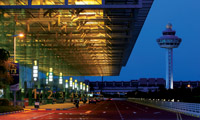Year End Review: Airports
World beaters
December 1st 2012
Staggering. That’s about the only word to describe the Asia-Pacific airport boom. Nowhere else in the world comes close. Read More »
 |
| Singapore Changi International Airport: to double in size and build a third runway |
And nowhere else can compete with the expansion in China which is building 70 new airports in the next few years and upgrading 100 existing facilities. The country will have 230 airports by the end of 2015.
In mid-year, Airports Council International (ACI) reported that 16 of the fastest growing airports in the world were in the Asia-Pacific. In August, Jakarta’s Soekarno-Hatta International Airport was ranked the fastest growing airport worldwide, with around 170,000 extra seats booked compared with the same month a year earlier.
Soekarno-Hatta, like so many other airports in the region, is bursting at the seams. It has announced plans to triple its size by 2014 at a cost of $2.8 billion.
Built to handle 22 million passengers annually, in 2011 its throughput grew 19.2% to reach 52 million. The expansion will raise its capacity to 62 million.
Garuda Indonesia wants to more than double its passenger numbers by 2015. The airline’s president, Emirsyah Satar, said early this year that Garuda would only achieve this if Indonesian airports were expanded and access infrastructure was improved. He wanted to see new link roads and railways to major airports.
Meanwhile, in July, work on a $2 billion expansion of Bangkok’s Suvarnabhumi International Airport began. In August, the green light was given to the building of its third runway.
Singapore has allocated 1,000 hectares of land for the expansion of multi-award winning Singapore Changi International Airport, a move that will almost double the airport’s size and will include a third runway.
In 2010 and 2011, Changi handled record numbers of passengers, topping 42 million and 45 million respectively. It is likely to top 50 million this year.
In March, the Hong Kong Government gave its in-principle approval to the construction of a third runway at the city’s Chek Lap Kok airport.
Fiercely opposed by environmental groups, the project is forecast to cost $17.4 billion, the largest single development in the city in monetary terms. A final decision is not expected until 2015 and the runway will take eight years to build. It will require 650 hectares of sea reclamation.
The Airport Authority of Hong Kong has not ruled out a levy on airport users to finance the project.
If ever there was proof of the runaway success of LCCs in Asia, it was the decision by Malaysia Airports Bhd early this year to almost double the previously planned size of its second low-cost carrier terminal (LCCT).
Currently under construction at the Kuala Lumpur International Airport, and to be known as KLIA2, the terminal will be completed in mid-2013. It will have its own runway and control tower.
The LCCT will cater for 45 million passengers a year, up from the original estimate of 30 million. It will have a four kilometre runway instead of the initially planned 2.5km, with 68 gates and eight remote stands. The planned two-storey terminal building has been upgraded to nine stories on a 257,000 sq. metre site, an expansion from an original 150,000 sq. metre site.
Political upheaval in Japan has resulted in a privatisation plan for 27 regional, state-managed airports being put on hold.
A bill to encourage private sector investment in the airports that could lead to lower landing fees was passed in March. It had been expected to meet with cross party approval in the Japanese legislative assembly (Diet) and be introduced in the summer.
Currently, the management of most airports in Japan is split between the Ministry of Land, Infrastructure and Transport (MLIT), which controls landing charges and flight operations.
The operation of passenger and cargo terminals and ancillary services, such as car parks, is usually controlled by specially created companies at each airport.
Once the bill has passed through the Diet, the MLIT will sell airport management rights to new, privately-owned airport operating companies that will have the power to set landing fees in a more competitive business environment.
Eventually, the government wants to include another 67 airports, now controlled by local governments, in the plan. Only 21 of Japan’s 97 airports are making money.
In November, Narita airport cut its landing charges for international flights by 5.5%. Apart from a temporary reduction during the 2008 financial crisis, this is the first time the airport has cut landing fees since 2005.
Philippine Airlines (PAL) surprised many people in September when president Ramon S. Ang told local media the carrier wanted to build its own airport.
However, there are major hurdles to overcome. For example, winning government approval and finding 2,000 hectares of land on which to build the airport. Ang is confident of overcoming any obstacles. He has predicted that work could start as early as next year on the facility and be completed in three years.